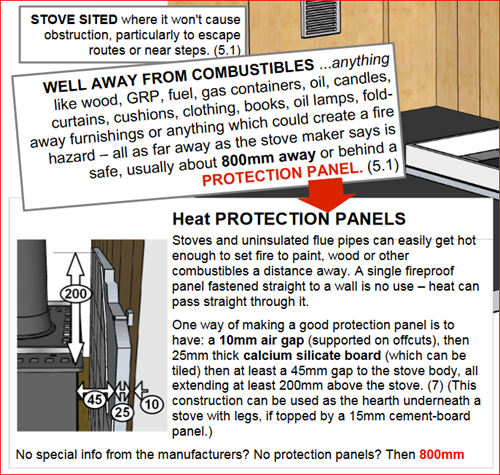...take time to maintain it.
Always follow the instructions published by the manufacturer or supplier on how to use and how to mainten the stove .
Checking for signs of problems
Keep a close eye on the stove condition Make the following checks regularly as a routine:
- Check stove liners and replace them if they are starting to crumble
- Check the stove body for any signs of cracks, distortion or missing plates
- Check for damaged or cracked glass or missing, damaged or poorly installed seals.
Repair or replace any faulty item that can be fixed. If there's a more difficult problem e.g. a cracked stove body, consider replacing the stove, they don't last forever.
Here just a few points
Is the door still making a good seal and is the rope seal in good condition?
Has the back or top plate (as appropriate) worked loose?
Is the flue still well-sealed all the way to the cabin roof? A sooty smear at a joint could be a bad sign.
Even a tiny rust hole in the chimney can let air in again which cools the smoke, stops it rising, and risks poisonous CO gas leaking out.
A clean flue will help keep a good draw and so will running the stove at the right temperature.
When was the last time you checked it or had your chimney swept?
If you haven't been to the boat since last year, check to see if birds or mice have built a nest in your chimney.
With repairs or sweeping, if you are at all uncertain what to do, call in a professional who can do the job to the proper standards.
On the cabin roof, has the flue terminal been damaged, perhaps it's been clouted? Never use a stove that has a crushed flue terminal.
What about the general air supply to the stove? Check the boat's ventilators are still OK. Have they become choked or restricted for example by spiders' webs or leaves has someone deliberately blocked a ventilator trying to stop drafts?
When refuelling, guard against embers falling out onto wooden floors, rugs or other flooring materials or sparks shooting out and onto cushions or the dog's basket.
When running the stove, keep the stove's door shut, or ensure the hearth has a lip to catch embers and consider using a fireguard.
Keep all combustibles such as fuel logs, wood furniture, clothing soft furnishings, books and paper at least an arms length (800mm or as specified by the manufacturer) away from from the stove, or they must be protected by a insulating panel that cuts radiated heat.

Image from Solitec
Be careful how you handle hot ash, it gives off CO, so don't leave ash to cool in the cabin or covered cockpit area.
Don't tip any ash or embers into public or marina bins until it is stone cold, warm ashes can still have burning embers. Only use a metal bin or bucket on your own boat, choose ones with lids so burning embers don't blow back into the cabin.
Do not tip ash and embers into the waterway, it can harm water quality.
